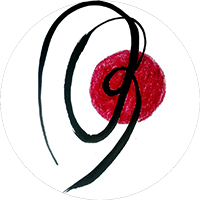Jasper focal with disc pearls and swarovski crystal, mounted on adjustable cord; designed and executed by Tammy Vitale $25.00
The following question is based on "the myth of the Bright Path" discussed in chapter 6 of Molly Gordon's book, The Way of the Accidental Entrepreneur: "There is a myth in our culture that the path to success should be bright. If discouragement or depression come calling, we simply need to meditate more, take the right supplements, use the right affirmations, visualize white light, and things will be perfect.
"Well, things are perfect, but sometimes perfection feels crummy…What if, for the accidental entrepreneur, success has more to do with the learner you are than the expert you have become?
"Errors are the compost for success."
At first I thought I might run through and underline the great points of Molly's answer for those of you who like to skim. Then realized I'd have to underline the whole response. So I didn't. Don't skim. Read. and don't forget to comment : Everyone who comments gets a free copy of Molly's Sanity Saver e-book and gets entered to win a FRE*E gold membership for The Self Employment Telesummit September 10-22, 2009.
Tammy: The myth of the Bright Path. Talk about realistically setting goals: what does that look like? What is a baby step? How do we measure ourselves against our expectations? (Some of us have BIG expectations. Ahem). What is the next step when one is freaking out over the economy, over the market changing overnight (or at least it feels like it), over people who seem to sail through it nonetheless, over $$. Especially over $$.
Molly: Realistic goals are so important. As you say, some of us have awfully big expectations, and often those expectations don't line up terribly well with what we really care about. If they lined up better, I suspect we'd come closer to meeting those expectations.
So let's begin by making a distinction between an expectation, which is the belief that something is likely to (or should) happen and a goal, which is more akin to a destination. These are entirely different critters.
Expectations have a flavor of passivity. They are governed by the way things are or, at least, the way we think things should be. In the olden days (even older than we are, Tammy), folks would talk of a person's expectations, referring to his or her inheritance.
Goals are all about action. When you have a clear cut goal, you measure your progress according to how near or far you are from the goal. Whether or not you expect to reach your goal is less important than whether or not you plan to do so.
I think a lot of pain among Accidental Entrepreneurs comes from avoiding goals. When we don't have clear goals, we are left with mushy expectations. As I suggested earlier, those expectations often aren't ones we would choose, if we were really paying attention.
An artist, for example, may avoid setting an income goal because she's afraid she'll fall short or even because she just doesn't know how to go about arriving at a dollar amount. Lacking a specific goal, she goes about her business all year, feeling good when money comes in and feeling bad when it doesn't. Let's say that, on the whole, she's feeling pretty satisified with herself. One day she learns that another artist earned $10,000 at a weekend art fair. This is three times as much as she's ever earned at one event, and suddenly, she judges herself to be a failure.
So how do you set goals and get out of the expectations and comparison game? I suggest you start with your current set point. Most of us have a dollar amount that we earn pretty reliably. It may be more than we need or less, but it's an amount that we're comfortable with. We didn't choose it exactly, yet it controls our income just as surely as a thermostat governs the temperature in your living room.
First, realize that you know how to make this amount of money. You've already demonstrated that you can reach this goal. (It has been a goal, even if an unacknolwedged one.) Now set a new goal that is enough higher to make you breathe a bit faster but not so high as to make you faint. Write this down and let it be your new financial goal.
When you have this new number, start thinking about all the ways you could earn this money. You could raise prices on some items. You could teach a class. You could write a book. Look at everything you do and sketch out some different ways that you could increase your income just this much.
Then go into action. Earn this larger amount of money, then repeat the process. You'll be stretching your comfort zone without freaking yourself out. By keeping the increase modest (yet exciting) you'll be working toward a goal that is sufficiently realistic that economic ups and downs won't have much impact.
Most of all, you'll be in action working toward a purpose you have chosen instead of reacting to shifting expectations and circumstances.
***
Wow. And this is just day one. Action plan and all. Hope you enjoyed this and will come back for more. But in case you can't wait: Free articles on meeting the challenges of self-employment

The Way of the Accidental Entrepreneur: How to Build a Business that Fits Just Right.




12 Comments
[…] is Molly Gordon. I have interviewed Molly for this Blog about her book (The Just Right Price, and Keeping it Real) back in 2009 – and was following her even before then. She’s offering a free […]
I'm really excited about the number of different ways an artist can think about increasing their income. As a crafter, it's really not that much of a stretch for me to come up with a class or two to teach – or if I use my wildest imagination, I guess I could see making kits or an instruction-style book. It's a little bit scary and pushes me outside of my comfort zone – but that is exactly where Molly is urging us to set that goal. Thanks for posting this interview and giving me a new perspective about my work's worth and goal-setting.
This interview has given me more insight and has broken down the tough questions into my kind of language-clear, concise and to the point! I've just read it about 3 times in a row, and would like to ask if I could have permission to print it out and strategically place copies in several places throughout the house. Obviously, what you had to say had a strong impact on me, and I thank you for that! And Tammy, thank you for always having such great context on your blog! And before you remind me that it's been way too long since I've posted on my blog-just watch, wait, and see-things are going to be changing!
This is great. I like the plan of writing down exactly what you need and then looking creatively at how you can generate that amount. I just did that this morning!
Thanks for the great blog and conversation!
In my support group with my colleagues, we talk a lot about goals. We talk about setting goals in a bullseye/target format. Set a higher goal for the bullseye but set one you'll be happy with on the outer ring. That way you're not afraid of not meeting your goal but can still aim out of your comfort zone.
How cool is this?! Molly's comments on both our
blogs, and such helpful insights! Thanks to both
of you for the food for thought for this week!
As my mentor keeps telling me, any action helps.
Tammy,
What are some tangible examples of investing in yourself? Your web page and slideviews of your jewelry are beautiful. It appears that you are steamrolling through your work with enhanced zeal!
Thanks for the encouragement to get the goals separate from expectations. I dance with it, and find oh so many ways to avoid committing.
Wow, I loved hearing the distinction between goals and expectations! Great stuff. Thanks, Tammy and Molly!!
I needed this today. Thank you.
Helpful advice for anyone who wants to accomplish something but isn't sure how to get there. "Errors are the compost for success" could be the mantra for much of my life!